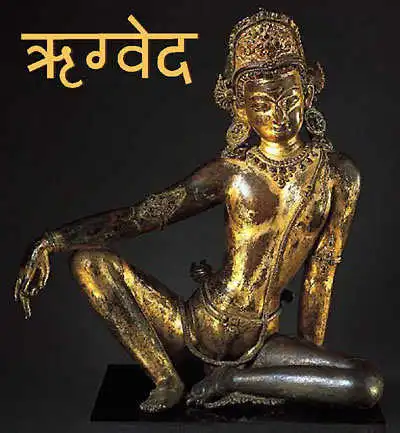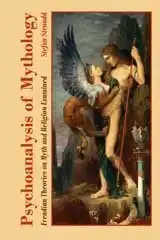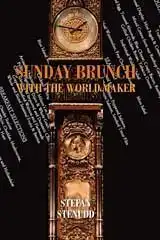
The Creation in Rig Veda 10:129A Synthesized Version of the Hymn
Seven English Versions of Rig Veda 10:129 SynthesizedAfter examining seven major translations of Rig Veda 10:129, I need to compose a synthesized version of the hymn based on them, before moving on to making suggestions about how it might be interpreted. So, here is the hymn as I perceive it.
As implied by my comments on the seven English versions presented on this website, parts of the hymn are uncontroversial with very similar interpretations from all the seven translators, whereas other parts are much more complicated. A pattern emerges, but I return to that later. Below is my synthesized sketch of the hymn, where I have tried to give it as much clarity as possible. Mainly but not always, I have followed the majority of the seven translators where that could be calculated, but also I have allowed myself some freedom where I felt it was called for in seeking out what the poet of the hymn is most likely to have intended. Of course, since I am not an indologist my choices are based on other things than any profound knowledge of the original poet's context. Apart from the arguments of the translators, I have mostly considered the hymn's inner logic and my understanding of patterns in creation myths as well as ancient cosmogonic thought. I will discuss my choices below. Here is my synthesized version of the Rig Veda 10:129 creation hymn:
Rig Veda, Mandala 10, hymn CXXIX. Creation.Nasadiya Sukta ("Not the non-existent")
First Verse ChoicesAs for the first verse, its content is not that controversial. The seven translators differ only in minor details, not in the general statement of the verse. Mainly, they describe the yet non-existent cosmos in different terms.They all make it clear that both references in the second line are to celestial components. They just name them differently. The hymn suggests that there are two levels of the celestial yet to be created. I choose the words sky and heaven, in the hope of giving the impression of one layer closer to earth than the other. That's what the hymn specifies quite clearly, whatever English words we use. Nothing else in this verse causes any great conflict between translations.
Second Verse ChoicesAlso regarding the second verse, the seven translators pretty much agree. Their choice of words may vary, but not really so that they alter the meaning of the verse. Therefore, I had no trouble finding a straightforward way of writing it, which I trust that none of the seven translators would disapprove, at least not with any emphasis.Everyone except Joel P. Brereton chooses immortality as the opposite to death. He calls it deathlessness, which is interesting in its much more limited assumption, but I go with the majority. Furthermore, it is very likely that the poet expected the audience to think about mortal earthly beings on one side and immortal divine creatures in heaven on the other. As for night and day in the next line, A. L. Basham has explicitly mentioned the light (in the form of a torch), since that is what makes day emerge. The others haven't, but talk about the lack of a sign or indication. Anything specific would assume more of the cosmology than what seems appropriate at this time in the hymn. There was no sign of either night or day, but the hymn doesn't seem to venture into what that sign would be, specifically. So, I don't specify it. But the text of the hymn indicates that this obscurity is in the perspective of a potential (but non-existent) observer. So I implied it. The line where the One is introduced causes some problems for the translators, but they mainly agree on what is stated also in my synthesized version. The One breathed without air, since that was yet to be created, and did so without any outer means. I know the term "autonomously" lacks the ancient flavor, but I chose it to avoid specifying gender. Although the One is later described as male, it doesn't really apply to the chaotic state before creation commences and the One is awakened to become self-aware.
Third Verse ChoicesIn the third verse, the seven translators agree pretty much about the first two lines, but not so with the following two. That's when creation commences, which is a vastly important moment — especially in this poem, with its punch line of that being hidden to all.It's not even so that all the translators specify the role of the One in this, though it still might be implied. Max Müller talks about a germ, H. H. Wilson about a united world and Ralph T. H. Griffith a unit. Still, it's safe to say that they all refer to the mysterious One mentioned already in the second verse of the hymn. The translations divide as to what makes creation begin. Most of them say that heat got the process going, but Wilson suggests austerity. Griffith says warmth, which is just heat with a milder choice of word. As for how they form this sentence, none is identical to the other. In spite of these differences, what is described is quite the same — with the possible exception of Wilson. Creation begins with a rise of temperature. That may be symbolical, but the text hints nothing of it. My problem was with the word "emerged." I considered an awakening, since that seems to be what the One goes through, but it would presuppose too much. The seven translators have different solutions: "burst forth," "produced," "born," "came into being" and "arose." I did not want to use the concept of birth, since the One is said to already exist in some way or other — even breathing. It is an awakening, but without any support from any one of the translators, I had to settle for emerge.
Fourth Verse ChoicesDesire as the primary force of creation is uncontroversial. Only Müller chooses another word, love, which is probably just in an effort not to challenge the prude ideals of his time. As for the seed in the second line, it's the choice of five translators. Joel P. Brereton uses "semen" instead, which is probably quite correct. Again, the other translators may have wanted to soften the sexual innuendo.I stick with seed, not only because of the majority of translators, but to avoid gender specifics at this stage. The verse describes desire as the first seed of mind. The metaphor of a seed of mind makes more sense as a starting signal to the growth of a whole world, than semen of the mind would. The latter would suggest self-fertilization, like that of Chepre in an Egyptian creation myth. But the One of Rig Veda 10:129 is a different creator, triggered by desire to move from a vague passive existence into action. The One's creation is more of an outward activity than Chepre's inward fertilization.
 Indra. Gilt bronze, Nepal 18th century. As for the poets of the next line, four of the translators chose "sages" instead. Joel P. Brereton points out that the Sanskrit word indicates not just any poets, but those with profound understanding. So, "wise poets" is a way of combining those traits. It is interesting that these poets searched their hearts. That might be a Western interpretation, since our tradition gives the heart a role rightly belonging to the brain. We have seen it as the seat of moral, courage, compassion, and so on. We still use the heart as a symbolic home of such things. That might have influenced the translators in their choice, but all seven do the same, so it must be well-founded. Also, the Western tradition is far from the only one giving the heart credit for things of the brain. That is probably due to its tendency to change the frequency of its beats when we are overcome by some sentiments. The last line of the fourth verse has created some diversity among the translators. Most of them describe a link between what is and what is not, albeit with slightly differing wordings. But three of them — Macdonell, Doniger and Brereton — describe existence as if it was contained within non-existence. That could be implied by "darkness concealed in darkness" of the third verse, existence as a hidden potential inside non-existence, but I find it unlikely. The dynamics of creation described by the hymn is a process where opposites have to appear and take shape, since one cannot exist without the other. Neither existence nor non-existence is possible without its counterpart. That would be the bond between them, and that makes the world take form, as stated in the first line of the fifth verse.
Fifth Verse ChoicesAll translators except Müller choose the expression "their cord" in the first line of this verse. That makes it unclear if the poets or the two opposites of existence and non-existence are intended. I have no doubt that the latter is what the poet intended. To avoid misunderstanding, I write "that cord."The bond between existence and non-existence is a cord extending through an emerging cosmos, as the opposites manifest themselves by the necessity of their interdependent opposition. Surely, that's a division into heaven and earth, which is what almost every creation myth describes. So, what was above and what below was no real mystery to the original audience of this hymn. But the question is not just rhetorical. It points out the many remaining mysteries regarding the heavenly as well as the earthly, also in particular the uncertainty of their roles in the continued process of creation. It's no wonder that the translations of this verse differ quite a lot. They are all rather clear about some kind of fertilization taking place between the above and the below, where the former must surely be the seed and the latter the womb. But in describing the characteristics of those two, the translations diverge — even contradicting each other. The hymn describes both as powers, not necessarily one superior to the other. I call the upper one "will," since the hymn seems to see it as the initiator. It is, after all, the seed. I call the lower one "urge," because several of the translators indicate that the hymn allows it some say in the process, not just being a passive receiver. It engulfs the seed from above and uses it in the following procreation. The below has an urge to take part in creation.
Sixth Verse ChoicesThe complications of the fifth verse are gone when the sixth is reached. There is wide consensus among the translators as to how to word it and what it means. The poet suddenly interrupts the narration of creation and returns to the question asked in the beginning: who can really say what happened?The word "here" points out an audience to the poet in a now setting. Five of the seven translators use it. So do I, since it points out so clearly that the poet brings the audience back to the present, far away from the distant moment of creation. Here and now, instead of back then, who can say what happened? The shift of perspective makes the question even more mind-blowing. The use of "this creation" in the next line has a similar function. It points to the contemporary observers of the world they live in. My problem with this verse is a minor one — the word "creation." All the seven translators use it. Actually, six of them do it twice. What makes me hesitate to use this word is all that it implies, such as an active and intentional process of making the world, which in turn also suggests a maker. We should not jump to the conclusion that all this is what the poet had in mind. I checked the Sanskrit word (at spokensanskrit.de) and there is no doubt that "creation" is a proper translation of it. But the Sanskrit word (visrsti or visarashti) also means: offspring, emission, offering, discharge, letting go, quitting, leaving, allowing to flow, production, and giving. So, it seems to have other connotations than the divine magic of making the world appear, as we tend to see it in the Judeo-Christian tradition. The Sanskrit word suggests a creation process similar to feeding: once the world is fed it pretty much takes care of its own continued evolvement and multiplying. As implied by the fifth verse, the creation in Rig Veda 10:129 is one where both the above and the below are active. Maybe the latter soon takes over the process, whereas the above is reduced to a passive source of energy for it. That's quite different from the Genesis I and II descriptions of creation, where god is the only one making things happen for quite a while, until every creature on earth has been produced. As for the second use of the word "creation" in this verse, the translators vary. Müller puts it in the fourth line and five others in the third. Griffith uses synonyms. That gave me the freedom to avoid it completely. The third line simply states that the gods were introduced later, when there was already a world or cosmos of sorts. The fourth line refers back to the second line and it makes sense that the wording is at least similar. This is the choice of most translators. It is also the way the seventh and last verse starts.
Seventh Verse ChoicesThere is even less controversy among the translators about the last verse of Rig Veda 10:129 than there is about the previous one. They all come quite close to one another in the wording and definitely so on what is implied.It starts with the same enigma by which the sixth verse ended. Where did it all come from? As for the overseer in the highest heaven, the hymn doesn't state so firmly but it makes sense that it is the One of previous verses. Then it is confusing that the One as the creator is put to question. Wasn't that already determined by the third verse? Actually not. The One is the first to emerge, but the following verses don't specify this being's active role in creation. It seems almost to happen by itself, at least to begin with. So, this question in the last verse is not completely out of the blue. What the hymn ends by concluding is that not even the very first being to appear is sure to know how it happened. This punch line, certainly the main reason for the poet to write this hymn, has to end with a question mark. Only one of the seven translators, Joel P. Brereton, does so. He even uses a triple-dot ellipsis to stress the paradox more, which is fine by me. The only reason I don't do the same is that it's such a modern technique. It becomes odd as the last sentence of a 3,000 years old hymn from India. But I bet that the poet had a similar effect in mind when writing the last line — probably giggling when doing so.
Conclusions about Rig Veda 10:129The Creation in Rig Veda 10:129The Paradox of Origin
MENUCreation Myths Around the WorldHow stories of the beginning began.
The Meanings of MythologyTheories through history about myth and fable.
Archetypes in MythsThe mythological symbols and what they stand for.
The Logics of MythPatterns of creation.
CREATION MYTHS IN DEPTHCreation in Rig Veda 10:129The paradox of origin, according to an Indian myth.
Genesis 1The first creation story of the bible scrutinized.
Enuma ElishThe ancient Babylonian creation myth.
Xingu Creation of ManThe insoluble solitude of gods and humans.
ContactAbout Cookies
ON MY OTHER WEBSITESPsychoanalysis of MythWhat Sigmund Freud and C. G. Jung thought about myths, their origins and meanings.
Myth of CreationAn introduction to the subject of creation myths and the patterns of thought they reveal.
Cosmos of the AncientsWhat the Greek philosophers believed about the cosmos, their religion and their gods.
Life EnergyThe many ancient and modern life force beliefs all over the world explained and compared.
TaoisticTaoism, the ancient Chinese philosophy of life explained. Also, the complete classic text Tao Te Ching online.
|
 Archetypes of Mythology
Archetypes of Mythology Psychoanalysis of Mythology
Psychoanalysis of Mythology Cosmos of the Ancients
Cosmos of the Ancients Life Energy Encyclopedia
Life Energy Encyclopedia Sunday Brunch with the World Maker
Sunday Brunch with the World Maker Fake Lao Tzu Quotes
Fake Lao Tzu Quotes Stefan Stenudd
Stefan Stenudd